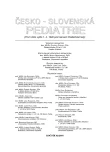Childhood Obstructive Sleep Apnea
Obstrukční spánková apnoe dětského věku
Poruchy dýchání ve spánku způsobené obstrukcí horních cest dýchacích (obstrukční spánková apnoe) se vyskytují u 2–3 % dětí s maximem mezi 3.–8. rokem života. Na obstrukci se podílí zvětšení adenoidní vegetace a tonzil, ale také odchylky struktury a inervace horních cest dýchacích, částečně podmíněné geneticky. Zvýšené riziko pro výskyt obstrukční spánkové apnoe představují také všechna onemocnění spojená s hypotonií a zúžením horních cest dýchacích. Obstrukční spánková apnoe způsobuje chronickou intermitentní hypoxii a opakovanými probuzeními vede k fragmentaci spánku. Důsledkem jsou změny kognitivních funkcí, poruchy chování, emocí a nálady, neprospívání, porucha růstu a kardiovaskulární onemocnění.
Spolehlivou diagnózu obstrukční spánkové apnoe u dětí umožňuje noční polysomnografie. Léčbou první volby je provedení adenotomie a tonzilektomie. U menší části dětských pacientů je indikována léčba pozitivním či dvojúrovňovým přetlakem v dýchacích cestách.
Klíčová slova:
obstrukční spánková apnoe, dětský věk, kognitivní funkce, porucha pozornosti s hyperaktivitou, noční polysomnografie, adenotomie a tonzilektomie
Authors:
I. Příhodová
Authors‘ workplace:
Neurologická klinika UK 1. LF a VFN, Praha
přednosta prof. MUDr. E. Růžička, DrSc.
Published in:
Čes-slov Pediat 2007; 62 (11): 631-637.
Category:
Review
Overview
Sleep-disordered breathing caused by upper airway obstruction (obstructive sleep apnea) affects 2 to 3 % of children with maximum at the age from 3 to 8 years. Airway obstruction results from adenotonsillar hypertrophy but subtle changes in upper airway structure and innervation, partly determined genetically, are supposed to play a role. All diseases connected with hypotonia and narrowing of upper airway represent increased risk for sleep apnea. Obstructive sleep apnea results in chronic intermittent hypoxemia and repeated arousals leading to sleep fragmentation. Consequences include cognitive impairment, behavioral problems, emotional and mood disturbances, failure to thrive, growth retardation and cardiovascular complications.
Noctural polysomnography is required for establishing the reliable diagnosis of childhood obstructive sleep apnea. The treatment of choice is adenotonsillectomy in most cases. Only a small percentage of children benefits from continuous positive airway pressure or bilevel positive airway pressure treatment.
Key words:
obstructive sleep apnea, childhood, cognitive functions, attention deficit hyperactivity disorder, nocturnal polysomnography, adenotonsillectomy
Labels
Neonatology Paediatrics General practitioner for children and adolescentsArticle was published in
Czech-Slovak Pediatrics

2007 Issue 11
- What Effect Can Be Expected from Limosilactobacillus reuteri in Mucositis and Peri-Implantitis?
- The Importance of Limosilactobacillus reuteri in Administration to Diabetics with Gingivitis
Most read in this issue
- Fragile X Syndrome at the FRAXE Locus: Clinical and Molecular Genetics Diagnosis of Affected Family
- Childhood Obstructive Sleep Apnea
- Ezetimib – Selective Inhibitor of Cholesterol and Its Application in the Therapy of Familial Hypercholesterolemia in Children and Adolescents
- Fever at the Child Age. Emotional Background of Febrile State and Therapeutic Efforts of the Parents
